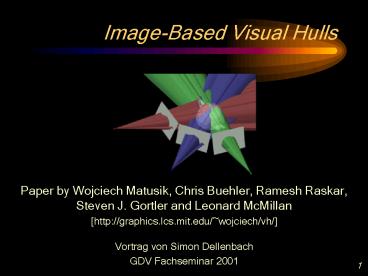Image-Based Visual Hulls - PowerPoint PPT Presentation
1 / 26
Title: Image-Based Visual Hulls
1
Image-Based Visual Hulls
- Paper by Wojciech Matusik, Chris Buehler, Ramesh
Raskar,Steven J. Gortler and Leonard McMillan - http//graphics.lcs.mit.edu/wojciech/vh/
- Vortrag von Simon Dellenbach
- GDV Fachseminar 2001
2
Overview (1)
- Motivation
- Basics
- Viewpoint Model
- Visual Hull
- Epipolar Geometry
- Creating Image-Based Visual Hulls
3
Overview (2)
- Rendering IBVH
- System Implementation
- Summary Results
- Future Work
- Personal Opinion
4
Motivation (1)
- Traditional computer graphics, rendering..
- static synthetic scenes (CG Images)
- dynamic synthetic scenes (CG Animations)
- static acquired scenes (Image-Based Rendering)
- Acquire and render dynamic scenes in real-time
- appropriate representation
- rendering system
5
Motivation (2)
6
Viewpoint Model - Basics (1)
7
Visual Hull - Basics (2)
- Geometric shape obtained using silhouettes of
object seen from number of views - extruded silhouette cone-like volume limiting
the extent of object - intersection of volumes results in a visual hull
- more views ? better approximation of object
- limitation concavities cant be captured(e.g.
an open box looks like a solid cube)
8
Visual Hull - Basics (3)
9
Epipolar Geometry - Basics (4)
- The tree points COP1,COP2,P form an epipolar
plane - Intersection of this plane with image planes
results in epipolar lines - The line connecting the two centers of projection
COP1,COP2 intersects the image planes at the
conjugate points e1 and e2 which are called
epipoles
10
Epipolar Geometry - Basics (5)
11
Creating Image-Based Visual Hulls (1)
- Algorithm input
- set of k silhouettes (binary images) with
associated viewpoints - desired viewpoint (in this case, constructed
visual hull is viewpoint-dependent) - Algorithm output
- sampled image of the visual hull, each pixel
containing a list of occupied intervals of space
12
Creating Image-Based Visual Hulls (2)
- The Basic Algorithm
- cast ray into space for each pixel in the desired
view of the visual hull - intersect ray with the k silhouette cones? k
lists of intervals intersect together? single
list of intersections of the viewing ray with the
visual hull
13
Creating Image-Based Visual Hulls (3)
14
Creating Image-Based Visual Hulls (4)
- Trick due to Epipolar Geometry interval
calculation can be done in image space of
reference images - 3D intersecting silhouette cone with viewing ray
- 2D intersecting projected viewing ray with
silhouette
15
Creating Image-Based Visual Hulls (5)
16
Rendering IBVH (1)
- Reference images are used as textures
- For each pixel
- rank reference-image texture from best to
worst according to angle, take reference with
lowest - avoid texturing surface points with an image
whose line-of-sight is blocked by some other
point of the visual hull - consider visibility during shading based on
visual hull (not actual geometry)
17
Rendering IBVH (2)
18
Rendering IBVH (3)
19
System Implementation (1)
- Four calibrated and triggered digital cameras
- One desktop PC per camera for capturing and
pre-processing video frames (image segmentation) - Silhouette and texture information sent to
central server for IBVH processing
20
System Implementation (2)
- Server runs IBVH intersection and shading
algorithms - IBVH objects can be combined with OpenGL
background - System runs in real time with heavy
optimization (like caching strategies for
silhouette intersection)
21
System Implementation (3)
22
Summary Results
- Use visual hull as object shape approximation
- Using silhouette information from reference views
to generate view dependent visual hull - Reference images are used as textures
- Results
- Videoclips
23
Future Work
- Find Techniques for blending between textures to
produce smoother transitions - Scale up system by using larger number of cameras
- Split workload on multiple servers, as algorithm
parallelizes fairly much - Speed up viewing ray silhouette intersections
(most expensive part of the computation)
24
Personal Opinion (1)
- Pros
- simple technique / low-cost hardware
- image-based representation partially compensates
simplification problems - epipolar geometry reduces 3D-intersection
problems to 2D-intersections
25
Personal Opinion (2)
- Cons
- texture flipping during viewpoint transitions
produces ugly results - shadows are considered as part of the object
- preprocessing is really expensive(85 ms for
image foreground segmentation)
26
The End
?
?
?
- If there are no questions,there wont be any
answers.
?
?
?































